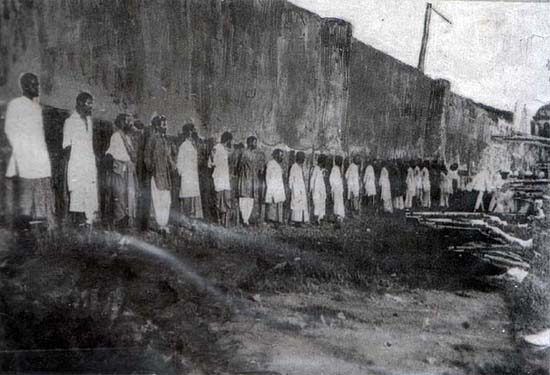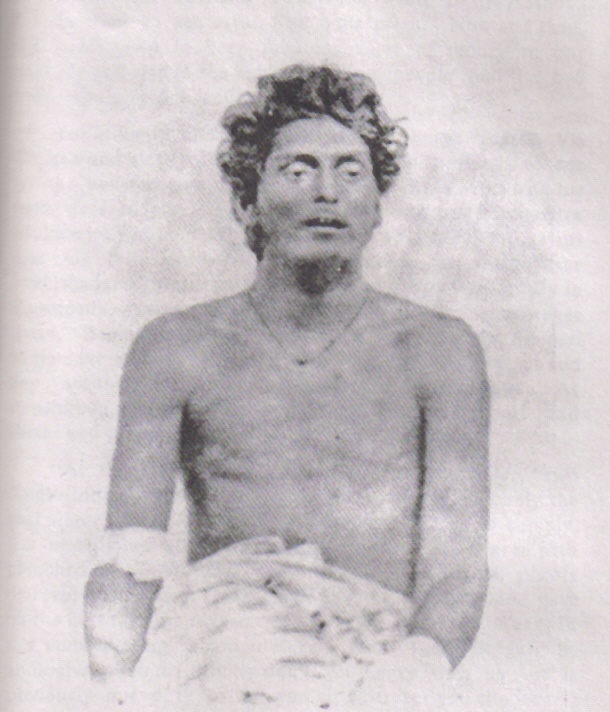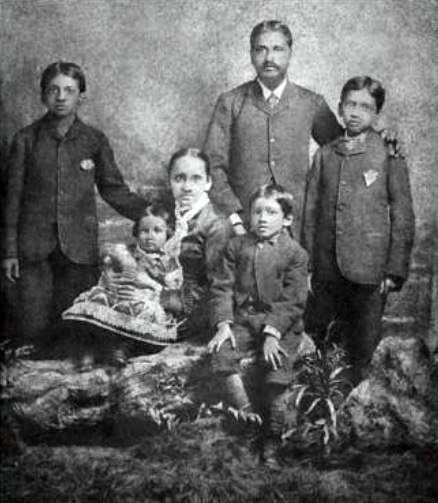|
Bipin Behari Ganguli
Bipin Behari Ganguly (5 November 1887 – 14 January 1954) was a member of Indian independence movement and a politician. He was born in Halisahar, Bengal Presidency (now in West Bengal), on 5 November 1887. His father's name was Akshaynath Ganguly. Revolutionary activities As a close associate of Barindra Kumar Ghosh and Rashbehari Bose he took active part in the revolutionary activities. He had a direct connection to the incidents like Muraripukur conspiracy and the bomb case. He was the founder member of Atmonnati Samiti, a secret revolutionary society and a fraction of Jugantar Group. During the beginning of World War I (1914-1918), the Indian revolutionaries decided to do something daring which would result in the procuration of a sufficient number of firearms for their cause of the struggle for Indian Independence. Already the scenario of protest against the British Rule had increased to an extreme after the 1905 partition of Bengal. It started with sedition case again ... [...More Info...] [...Related Items...] OR: [Wikipedia] [Google] [Baidu] |
Bowbazar
Bowbazar ( bn, বৌবাজার, also spelt ''Boubazar''; formerly known as Bahubazar) is a neighbourhood of Central Kolkata, in Kolkata district in the Indian state of West Bengal. History On Lt. Col. Mark Wood's map of 1784, the portion of the eastward road from Lal Bazar to what was known for a long time as Circular Road - which ran along the filled-in Mahratta Ditch and is now Acharya Jagadish Chandra Bose Road - was shown as Boytaconnah Street, which received its name from the Baithakkana, or "resting place", where merchants formed and dispersed their caravans, sheltered by an old banyan tree (called a peepul tree in Cotton), at the road's eastern extremity. Cotton, H.E.A., ''Calcutta Old and New'', 1909/1980, pp. 285–286, General Printers and Publishers Pvt. Ltd. Bow Bazar Street has been renamed Bepin Behari Ganguly Street (named after Bipin Behari Ganguli (1887–1954), revolutionary leader, who spent about 24 years in British Indian jails, later joining the ... [...More Info...] [...Related Items...] OR: [Wikipedia] [Google] [Baidu] |
Rodda Company Arms Heist
The Rodda company arms heist took place on 26 August 1914 in Calcutta, British India. Members of the ''Jugantar'' faction of the Bengali revolutionary organisation ''Anushilan Samiti'' intercepted a shipment of Mauser Pistols and ammunition belonging to Messrs Rodda & co., a Calcutta gun dealer, while these were en route from the Customs house to the company's godown, and were able to make away with a portion the arms. In Bengal, the revolutionaries achieved a major success in August 1914, when a large consignment of 50 Mauser pistols and 46,000 rounds of ammunition was appropriated by them from the Rodda firm in Calcutta through a sympathetic employee. The heist was a sensational incident, being described by ''The Statesman'' as the "Greatest daylight robbery". In the following years, the pistols and ammunitions were linked to almost all the incidences of nationalist struggles in Bengal. By 1922, the police had recovered most of the stolen arms. Background Western Anushilan ... [...More Info...] [...Related Items...] OR: [Wikipedia] [Google] [Baidu] |
1954 Deaths
Events January * January 1 – The Soviet Union ceases to demand war reparations from West Germany. * January 3 – The Italian broadcaster RAI officially begins transmitting. * January 7 – Georgetown-IBM experiment: The first public demonstration of a machine translation system is held in New York, at the head office of IBM. * January 10 – BOAC Flight 781, a de Havilland Comet jet plane, disintegrates in mid-air due to metal fatigue, and crashes in the Mediterranean near Elba; all 35 people on board are killed. * January 12 – Avalanches in Austria kill more than 200. * January 15 – Mau Mau leader Waruhiu Itote is captured in Kenya. * January 17 – In Yugoslavia, Milovan Đilas, one of the leading members of the League of Communists of Yugoslavia, is relieved of his duties. * January 20 – The US-based National Negro Network is established, with 46 member radio stations. * January 21 – The first nuclear-powered subm ... [...More Info...] [...Related Items...] OR: [Wikipedia] [Google] [Baidu] |
1887 Births
Events January–March * January 11 – Louis Pasteur's anti-rabies treatment is defended in the Académie Nationale de Médecine, by Dr. Joseph Grancher. * January 20 ** The United States Senate allows the Navy to lease Pearl Harbor as a naval base. ** British emigrant ship ''Kapunda'' sinks after a collision off the coast of Brazil, killing 303 with only 16 survivors. * January 21 ** The Amateur Athletic Union (AAU) is formed in the United States. ** Brisbane receives a one-day rainfall of (a record for any Australian capital city). * January 24 – Battle of Dogali: Abyssinian troops defeat the Italians. * January 28 ** In a snowstorm at Fort Keogh, Montana, the largest snowflakes on record are reported. They are wide and thick. ** Construction work begins on the foundations of the Eiffel Tower in Paris, France. * February 2 – The first Groundhog Day is observed in Punxsutawney, Pennsylvania. * February 4 – The Interstate Commerce Act ... [...More Info...] [...Related Items...] OR: [Wikipedia] [Google] [Baidu] |
Revolutionary Movement For Indian Independence
The Revolutionary movement for Indian Independence was the part of the Indian independence movement comprising the actions of violent underground revolutionary factions. Groups believing in armed revolution against the ruling British fall into this category, as opposed to the generally peaceful civil disobedience movement spearheaded by Mohandas Karamchand Gandhi. The revolutionary groups were mainly concentrated in Bengal, Maharashtra, Bihar, the United Provinces and Punjab. More groups were scattered across India. Beginnings Apart from a few stray incidents, the armed rebellion against the British rulers was not organised before the beginning of the 20th century. The revolutionary philosophies and movement made its presence felt during 1905 partition of Bengal. Arguably, the initial steps to organise the revolutionaries were taken by Aurobindo Ghosh, his brother Barin Ghosh, Bhupendranath Datta, Lal Bal Pal and Subodh Chandra Mullick, when they formed the Jugantar party in A ... [...More Info...] [...Related Items...] OR: [Wikipedia] [Google] [Baidu] |
Indian Revolutionaries
Indian or Indians may refer to: Peoples South Asia * Indian people, people of Indian nationality, or people who have an Indian ancestor ** Non-resident Indian, a citizen of India who has temporarily emigrated to another country * South Asian ethnic groups, referring to people of the Indian subcontinent, as well as the greater South Asia region prior to the 1947 partition of India * Anglo-Indians, people with mixed Indian and British ancestry, or people of British descent born or living in the Indian subcontinent * East Indians, a Christian community in India Europe * British Indians, British people of Indian origin The Americas * Indo-Canadians, Canadian people of Indian origin * Indian Americans, American people of Indian origin * Indigenous peoples of the Americas, the pre-Columbian inhabitants of the Americas and their descendants ** Plains Indians, the common name for the Native Americans who lived on the Great Plains of North America ** Native Americans in the Un ... [...More Info...] [...Related Items...] OR: [Wikipedia] [Google] [Baidu] |
Anushilan Samiti
Anushilan Samiti ( bn, অনুশীলন সমিতি, , bodybuilding society) was an Indian fitness club, which was actually used as an underground society for anti-British revolutionaries. In the first quarter of the 20th century it supported revolutionary violence as the means for ending British rule in India. The organisation arose from a conglomeration of local youth groups and gyms (akhara) in Bengal in 1902. It had two prominent, somewhat independent, arms in East and West Bengal, Dhaka Anushilan Samiti (centred in Dhaka), and the Jugantar group (centred in Calcutta). From its foundation to its dissolution during the 1930s, the Samiti challenged British rule in India by engaging in militant nationalism, including bombings, assassinations, and politically motivated violence. The Samiti collaborated with other revolutionary organisations in India and abroad. It was led by the nationalists Aurobindo Ghosh and his brother Barindra Ghosh, influenced by philosophies ... [...More Info...] [...Related Items...] OR: [Wikipedia] [Google] [Baidu] |
Kolkata
Kolkata (, or , ; also known as Calcutta , the official name until 2001) is the capital of the Indian state of West Bengal, on the eastern bank of the Hooghly River west of the border with Bangladesh. It is the primary business, commercial, and financial hub of Eastern India and the main port of communication for North-East India. According to the 2011 Indian census, Kolkata is the seventh-most populous city in India, with a population of 45 lakh (4.5 million) residents within the city limits, and a population of over 1.41 crore (14.1 million) residents in the Kolkata Metropolitan Area. It is the third-most populous metropolitan area in India. In 2021, the Kolkata metropolitan area crossed 1.5 crore (15 million) registered voters. The Port of Kolkata is India's oldest operating port and its sole major riverine port. Kolkata is regarded as the cultural capital of India. Kolkata is the second largest Bengali-speaking city after Dhaka ... [...More Info...] [...Related Items...] OR: [Wikipedia] [Google] [Baidu] |
Partition Of India
The Partition of British India in 1947 was the Partition (politics), change of political borders and the division of other assets that accompanied the dissolution of the British Raj in South Asia and the creation of two independent dominions: Dominion of India, India and Dominion of Pakistan, Pakistan. The Dominion of India is today the India, Republic of India, and the Dominion of Pakistan—which at the time comprised two regions lying on either side of India—is now the Pakistan, Islamic Republic of Pakistan and the Bangladesh, People's Republic of Bangladesh. The partition was outlined in the Indian Independence Act 1947. The change of political borders notably included the division of two provinces of British India, Bengal Presidency, Bengal and Punjab Province (British India), Punjab. The majority Muslim districts in these provinces were awarded to Pakistan and the majority non-Muslim to India. The other assets that were divided included the British Indian Army, ... [...More Info...] [...Related Items...] OR: [Wikipedia] [Google] [Baidu] |
Jatindranath Mukherjee
Bagha Jatin (; ) or Baghajatin, born Jatindranath Mukherjee (); 7 December 1879 – 10 September 1915) was an Indian independence activist. He was the principal leader of the Jugantar party that was the central association of revolutionary independence activists in Bengal. Early life Jatin was born in a Brahmin family to Sharatshashi and Umeshchandra Mukherjee in Kayagram, a village in the Kushtia, subdivision of undivided Nadia district, in what is now Bangladesh, on 7 December 1879. He grew up in his ancestral home at Sadhuhati, P.S. Rishkhali Jhenaidah until his father's death when Jatin was five years old. Well versed in Brahmanic studies, his father liked horses and was respected for the strength of his character. Sharatshashi settled in her parents' home in Kayagram with her son and his elder sister Benodebala (or Vinodebala). A gifted poet, she was affectionate and stern in her method of raising her children. Familiar with the essays by contemporary thought leaders li ... [...More Info...] [...Related Items...] OR: [Wikipedia] [Google] [Baidu] |
Beliaghata
Beliaghata, also known as Beleghata, is a neighbourhood of Central Kolkata, in Kolkata district, West Bengal, India. History The East India Company obtained from the Mughal emperor Farrukhsiyar, in 1717, the right to rent from 38 villages surrounding their settlement. Of these 5 lay across the Hooghly in what is now Howrah district. The remaining 33 villages were on the Calcutta side. After the fall of Siraj-ud-daulah, the last independent Nawab of Bengal, it purchased these villages in 1758 from Mir Jafar and reorganised them. These villages were known en-bloc as ''Dihi Panchannagram'' and Beliaghata was one of them. It was considered to be a suburb beyond the limits of the Maratha Ditch. In 1889, the 'fringe areas' of Maniktala, Ultadanga and Beliaghata were added to the Kolkata Municipal Corporation.Nair, P.Thankappan, ''The Growth and Development of Old Calcutta'', in ''Calcutta, the Living City'', Vol. I, p. 13, Edited by Sukanta Chaudhuri, Oxford University Press, 1995 ... [...More Info...] [...Related Items...] OR: [Wikipedia] [Google] [Baidu] |
Sri Aurobindo
Sri Aurobindo (born Aurobindo Ghose; 15 August 1872 – 5 December 1950) was an Indian philosopher, yogi, maharishi, poet, and Indian nationalist. He was also a journalist, editing newspapers such as ''Vande Mataram''. He joined the Indian movement for independence from British colonial rule, until 1910 was one of its influential leaders, and then became a spiritual reformer, introducing his visions on human progress and spiritual evolution. Aurobindo studied for the Indian Civil Service at King's College, Cambridge, England. After returning to India he took up various civil service works under the Maharaja of the Princely state of Baroda and became increasingly involved in nationalist politics in the Indian National Congress and the nascent revolutionary movement in Bengal with the Anushilan Samiti. He was arrested in the aftermath of a number of bombings linked to his organization in a public trial where he faced charges of treason for Alipore Conspiracy. However, ... [...More Info...] [...Related Items...] OR: [Wikipedia] [Google] [Baidu] |







